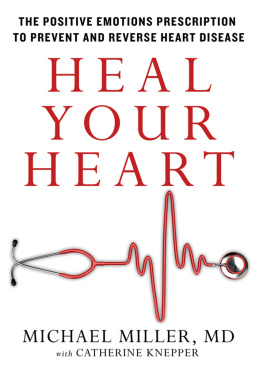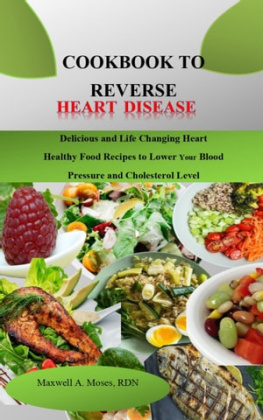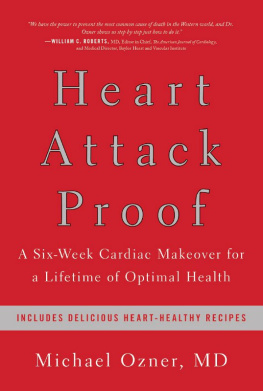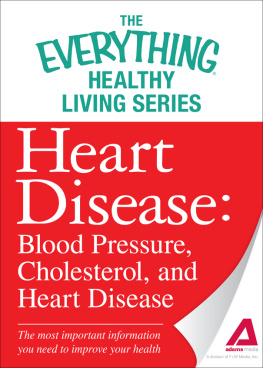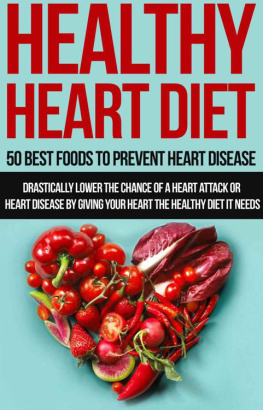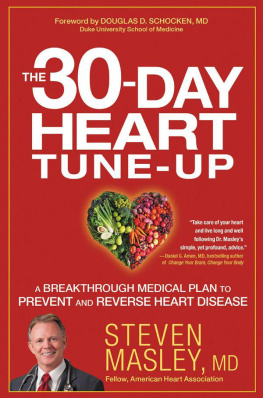This book is intended as a reference volume only, not as a medical manual. The information given here is designed to help you make informed decisions about your health. It is not intended as a substitute for any treatment that may have been prescribed by your doctor. If you suspect that you have a medical problem, we urge you to seek competent medical help.
Mention of specific companies, organizations, or authorities in this book does not imply endorsement by the author or publisher, nor does mention of specific companies, organizations, or authorities imply that they endorse this book, its author, or the publisher.
Internet addresses and telephone numbers given in this book were accurate at the time it went to press.
2014 by Michael Miller, MD
All rights reserved. No part of this publication may be reproduced or transmitted in any form or by any means, electronic or mechanical, including photocopying, recording, or any other information storage and retrieval system, without the written permission of the publisher.
Illustrations by Karen Kuchar
Book design by Elizabeth Neal
Library of Congress Cataloging-in-Publication Data is on file with the publisher.
ISBN 9781623363628
eISBN-13: 978-1-62336-363-5

We inspire and enable people to improve their lives and the world around them. For more of our products, visit rodalestore.com or call 800-848-4735.
To Lisa, my teal-eyed girl, with gratitude and love
PREFACE
NEARLY 10 YEARS AGO, I was contacted by literary agent Jill Marsal to discuss the possibility of writing a book related to the effects of positive emotions on the heart. My colleagues and I had just completed a research project demonstrating that laughter dilates blood vessels, which was in direct contrast to the blood vessel constriction we observed after our volunteers watched the harrowing opening segment of the movie Saving Private Ryan. Although these research results were promising, and although the effect of stress on the heart had been known for quite some time, research was still lacking with regard to how positive emotions benefit the heart. As a physician/scientist and researcher, I decided to hold off on writing such a book until more studies became available.
That time has now arrived. As research in our new subspecialty, behavioral cardiology, has blossomed, we have begun to uncover new ways to improve and maximize mind-heart connections. Think of it as your positive emotions prescription to good health. That is what this book is all aboutlearning to heal your heart by actively engaging in positive emotions each and every day. And while good nutrition and physical activity are necessary components to good health, they are unlikely to be sufficient if the soul of your bodys engine is ailing.
As a practicing physician with more than 25 years of experience, I have treated countless patients who time and again have beaten the odds by following a simple formula that combines good nutrition practices, daily activity, and perhaps most importantly, learning to foster positive emotions. Youll get to read about some of them in this book, and Ill guide you in how to use the same Positive Emotions Prescription they follow. This successful, proven plan, which combines the very best of traditional medicine with holistic practices that strengthen the mind-heart connection, has transformed my stressed-out patients at high risk for a heart attack and stroke into healthier women and men who have a more optimistic outlook and who have achieved sustained weight loss, lower blood pressure, and reduced cholesterol. Whether your heart is currently in need of healing, if you are at risk of heart disease, or if you simply want to keep your heart healthy, this book will show you how to get onand stay onthe road to excellent heart health.
ACKNOWLEDGMENTS
I AM INDEBTED TO the thousands of patients whom Ive had the privilege of taking care of at the University of Maryland Medical Center and the Baltimore Veterans Affairs Medical Center. Along the way, Ive been extremely fortunate to have had the opportunity to conduct medical research with giants in the field. They include Drs. Peter L. Carlton, Robert Deutsch, and Arthur Kling at Rutgers Medical School, with whom I learned a great deal about the amygdala and its role in processing emotions. At Johns Hopkins, my mentor, Dr. Pete Kwiterovich, taught me everything I know about cholesterol; Dr. Tom Pearson generously provided his large database so that we could study the importance of HDL and triglycerides in patients with heart disease; and Dr. Myron (Mike) Weisfeldt encouraged my research efforts in heart disease prevention during cardiology training. At the University of Maryland School of Medicine, Dr. Bob Vogel provided invaluable expertise in our positive emotion and nutrition-based research studies. Dr. Steve Havas was a great partner in the development of a novel nutrition-based education program for our medical students.
In writing this book, I owe a great deal of gratitude to the talented Catherine Knepper, who brought each chapter to life. Id like to gratefully acknowledge the assistance of Hannah S. Magram in drafting and editing the proposal to the publisher for the publication of this book. At Rodale, Lora Sickora has been an amazing editor who was encouraging from the outset and did a masterful job navigating the manuscript in a remarkably seamless manner. Finally, I have been very lucky to have Jill Marsal as my agent, as she has guided me through this process with unwavering support, a great deal of assistance, and extreme patience.
I am especially grateful to my children, Avery, Ilana, and Max, who provided much-needed positive emotions throughout this period. Finally, this book could not have been written without my wifes love and support, not to mention her delicious, mood-uplifting meals, recipes for many of which are included in this book. As I temporarily moved my office to the kitchen, no one was happier to have this project completed so that she could have her kitchen (and peace of mind) back!
INTRODUCTION
ONE BEAUTIFUL SUMMER EVENING in July 1963, my 31-year-old father met up with his friends for a game of baseball after work. Dad was a textile designer and a decorated veteran; tall and handsome and athletic, he was a man in the prime of his life. He loved those weekly baseball games, and he was a good player with a nice, compact swing. Back at our Brooklyn apartment, my mother had her hands full getting two rambunctious young boys bathed and ready for bed. (I had just turned 6, and my brother was 4.) On baseball nights, Mom set aside a plate of dinner for Dad, which shed warm and serve when he returned.
The phone rang and Mom left to get it, telling my brother and me to behave. She was back almost immediately, her face pale and afraid. Hurry and get dressed, boys, she said. Your fathers sick. Thats all she would say, but I knew it was serious. Later I would learn that my dad had collapsed on the baseball field and two of his teammates had rushed him to Coney Island Hospital.
By the time we arrived at the ER waiting room, most of the baseball team and some of my fathers family were already there. My unease grew. Finally someone called us back to see him.

